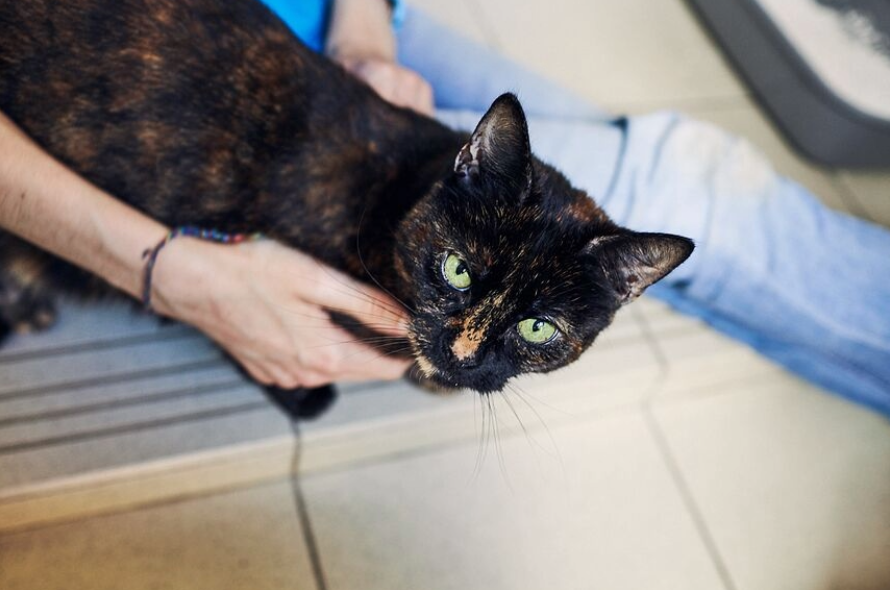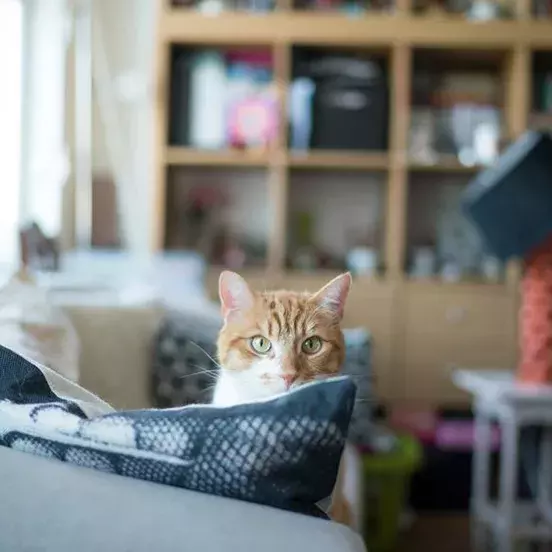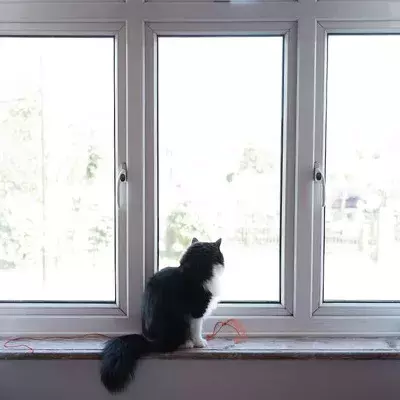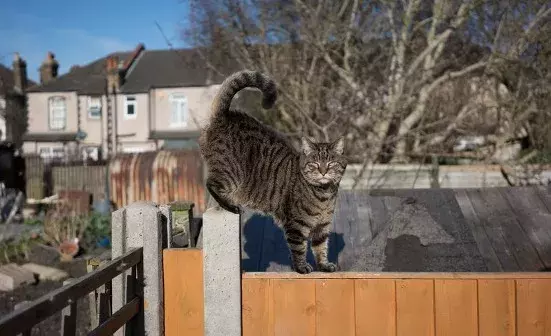Like humans, cats will feel frustrated when they feel like they’re not in control in some way, when their expectations are not met, or when they don’t have access to the things they want, such as food, play, time outside, or attention.

HOW CAN I TELL IF MY CAT IS FRUSTRATED?
Like humans, cats can feel frustrated for a few different reasons:
- They don’t feel in control of their environment. This could be either their physical surroundings or during interactions with humans or other animals.
- They feel their expectations aren’t being met. For example, the cat expects to be fed at a certain time or be given attention first thing in the morning, but this doesn’t happen.
- They are being denied access to something they want. This could be access to food, play, attention, the outdoors, or if they cannot escape to safety when they find themselves in a challenging or threatening situation.
Whilst it is normal for cats to experience some frustration from time to time, if this happens too often, and is experienced too intensely, the cat may be in danger of developing chronic stress. Frustration can affect your cat physically and emotionally and can result in undesirable behaviours, for example, aggression (directed to either people or other pets in the house), demanding or destructive behaviour, ‘spraying’ or going to the toilet outside of the litter tray.
Some cats may be more prone to experiencing frustration than others. It is difficult to predict exactly how a cat will behave in a new home. You may find your new cat is perfectly fine, or equally he or she may struggle. What you may think of as a stress-free situation could still frustrate your cat. Your cat’s frustrated body language signs will vary depending on the situation they’re in, but there are some things you can look out for to help you better understand how your cat is feeling.
Take a look at our video on understanding cat body language:
SIGNS YOUR CAT IS FRUSTRATED
- Your cat may seem very focused or fixated and determined to get to something. For example, if your cat wants to go outside but is frustrated because the cat flap is locked, they might constantly stare at the door, meowing loudly and scratching at it and won’t be easily distracted.
- Your cat may seem very alert, on-edge or jumpy. Their energy levels are likely to be high which is the body’s way of helping them to acquire the thing they need or prepare them to fight in order to stop something unpleasant from happening.
- Your cat may be very vocal, persistent, active and appear quite ‘frantic’.
- Your cat may be destructive e.g. scratching furniture, biting objects or knocking things over or off tables and shelves.
- Your cat may also behave aggressively, either directed towards the thing causing the frustration (e.g. when a person strokes them too much, they might swipe or bite) or redirected to something else because the actual trigger for the frustration is out of reach (e.g. when your cat looks through a window and sees an intruder cat in the garden, but can’t reach the intruder so instead swipes at a person who happens to be nearby).
SIGNS A CAT IS FRUSTRATED WITH YOU
- Your cat may move their head or body away from you.
- Your cat may sharply or quickly turn their head towards your face or hands (usually as a reaction to you touching them somewhere they’re not keen on).
- Your cat may approach you, interact, and then quickly walk away, potentially repeating this cycle multiple times.
- Your frustrated cat may growl, hiss, bite or swipe at you.
WHY IS MY CAT FRUSTRATED?
- They feel like they can’t get away from sounds, sights, or smells they don’t like (e.g., people chatting loudly or playing music, people rushing around or moving furniture about, even strong-smelling plug-in scent diffusers.)
- They don’t have their own access to things they find important, like having to wait be let outside, or if their access to parts of the house is suddenly restricted, for example if a spare room suddenly becomes a room for a new baby and they’re no longer allowed in. This can also happen if their resources are moved, for example if a litter tray is moved from a nice, quiet part of the house to a busy laundry room.
- If they’re bored and don’t have enough stimulation (e.g., a cat that is kept indoors or one who has outdoor access but to a garden that is bare and not very stimulating).
- If they don’t have the opportunity to hunt, chase, stalk and pounce, which are all natural behaviours for a cat (e.g., if the outdoor environment is not stimulating or if the cat is keen to play but owners aren’t able to play with the cat as often as it would like).
- For very food-focused cats, a delay in feeding or being stopped from accessing their food (e.g. the cat isn’t fed until 2 hours after its usual feeding time, or another cat in the house is blocking the cat’s access to its food bowl).
- For very friendly cats, not enough human interaction, or interaction at unpredictable times (e.g. if their owner works irregular hours and sometimes the cat is left alone for very long periods and then other times for very short periods of time)
- For less friendly cats, too much unwanted attention from humans or other animals
If family members have unpredictable routines, i.e. sometimes the house is very busy and chaotic and other times less so, but this does not follow any routine or pattern). - They’re being touched in a way the cat finds too intense. This is most likely when someone touches the cat’s tummy or back.
- The presence of another cat or cats in the house, garden or neighbourhood that the cat feels is invading its territory.
HOW CAN I HELP MY CAT'S FRUSTRATION?
If you think your cat might be frustrated, it’s important to try and figure out why, and what might be causing it. If possible, the best thing is to help your cat avoid the situations where they are most likely to become frustrated, and to give them choice and control in as many situations as possible. If this isn’t possible however, there are some things you can do to help your cat feel less frustrated:
NO SUDDEN CHANGES TO THEIR ENVIRONMENT
Make sure your cat’s environment is relatively predictable. This means that your cat knows roughly what happens when, where all their things are, like food, water and litter tray, and where they can go to have time on their own, undisturbed.
USE PUZZLE FEEDERS
Puzzle feeders make feeding times more interesting and more of a challenge, which is great mental stimulation for your cat. Puzzle feeders are generally made of plastic for ease of cleaning, and come in a range of different shapes and sizes. Some are ball shaped and roll around as the cat paws at them, whilst others are stationary and require the cat to push, scoop or lick at them in order to get the food. Puzzle feeders are designed to be used with either your cat’s treats, or their normal dry or wet food. It’s a good idea to check that your cat is able to access the treats or food in the puzzle feeders so that they find it stimulating rather than inadvertently increasing their frustration. You may need to show them how to use one. To keep the puzzle feeders interesting for your cat, we suggest using a couple and changing them each time you feed your cat.
KEEP PLAY TIME ENGAGING
Play is a really good source of mental stimulation for your cat. Some cats may prefer to play with humans, other cats with toys by themselves, and some cats may enjoy a combination of both. When you’re playing with your cat, it’s best to use long rod type toys with a toy on the end of a string so that the moving end of the toy is far away from you, and you’re less likely to get in the way of any playful teeth or claws. String toys should be stored away safely between play sessions, so your cat doesn’t become tangled up and potentially hurt themselves.
Toys that mimic the size, shape and texture of prey which your cat would naturally chase in the wild, can be particularly good to encourage their interest, and they may particularly enjoy playing with these prey-like toys on their own.
Toys impregnated with catnip can also be good for your cat to play with alone, although catnip can be quite arousing for some cats, so we advise that you don’t try to handle or touch the cat whilst it is under the influence!
MAKE SURE THEIR ENVIRONMENT IS STIMULATING
An environment that has lots of things to keep your cat entertained will provide them with excitement, fun and opportunities to engage their brain. Cats enjoy both being up high and having a good ‘vantage point’, as well as hiding and being concealed. Provide your cat with an environment that contains lots of elevated places they can climb up or jump on, as well as quiet places they can hide. Provide a mixture of cat trees, cat tunnels and shelving, combined with cat 'igloos' and cardboard boxes (see photos).
Cats also enjoy exploring and seeking out new sights, smells, sounds, textures and tastes. You can help to stimulate your cat’s senses indoors with the following:
- A large cardboard box or cat tunnel with leaves, food or natural feathers scattered inside.
Catnip toys that look like prey. - A range of cat-safe indoor plants, especially catnip and cat grass (visit the Petplan website for a list of specific plants to avoid).
- You can stimulate your cat’s senses outdoors as well. Take a look at our advice on making your garden or outside space cat-friendly for more information.
MAKE SURE THEY CAN ACCESS TO EVERYTHING THEY NEED
Make sure your cat has easy and constant access to everything it needs such as food, water, litter trays, resting and hiding places (these should ideally be located in quieter parts of the house), scratching posts, toys and access to the outdoors via a cat flap. We would recommend a microchip cat flap to prevent any other cats from being able to come inside.
KEEP HUMAN INTERACTIONS ON THEIR TERMS
Many friendly cats will greatly benefit from interacting with people, however for cats that are easily frustrated, this can quickly go from being enjoyable to being too intense and frustrating. We would suggest using the CAT acronym when interacting with any cat:
Choice
Did I give the cat a choice to tell me if it wanted to be touched, or am I giving it the choice to move away if it wants to?
Am I paying attention?
Am I looking out for any signs the cat might be trying to tell me they’re uncomfortable, like tail swishing, or equally any signs they’re happy to be touched?
Touch
Where am I touching the cat? Is this a place cats normally like to be touched, e.g. the cheeks, the top of the head and the shoulder blades, and not the tummy?
We’ve got more advice on the CAT acronym and how to interact with cats in our advice on how to stroke cats and interact with them.
If you are unsure or are still concerned about your cat’s behaviour in any way, we would recommend seeking advice from your vet who may be able to recommend a qualified feline behaviourist. If you rehomed your cat from Battersea, then you can get in touch with a member of the Cattery Team at Battersea for more information and advice using the details you will have been provided.



